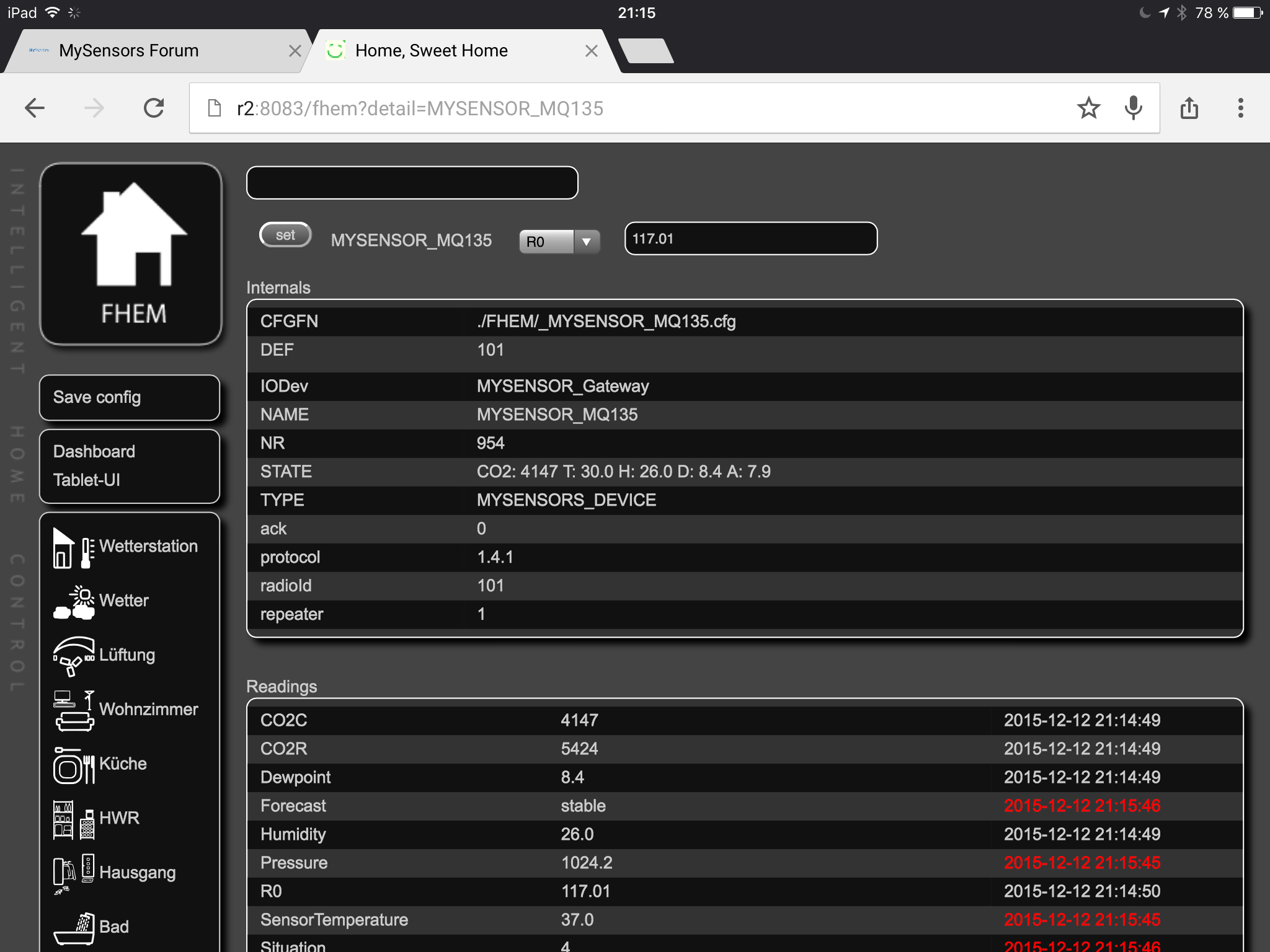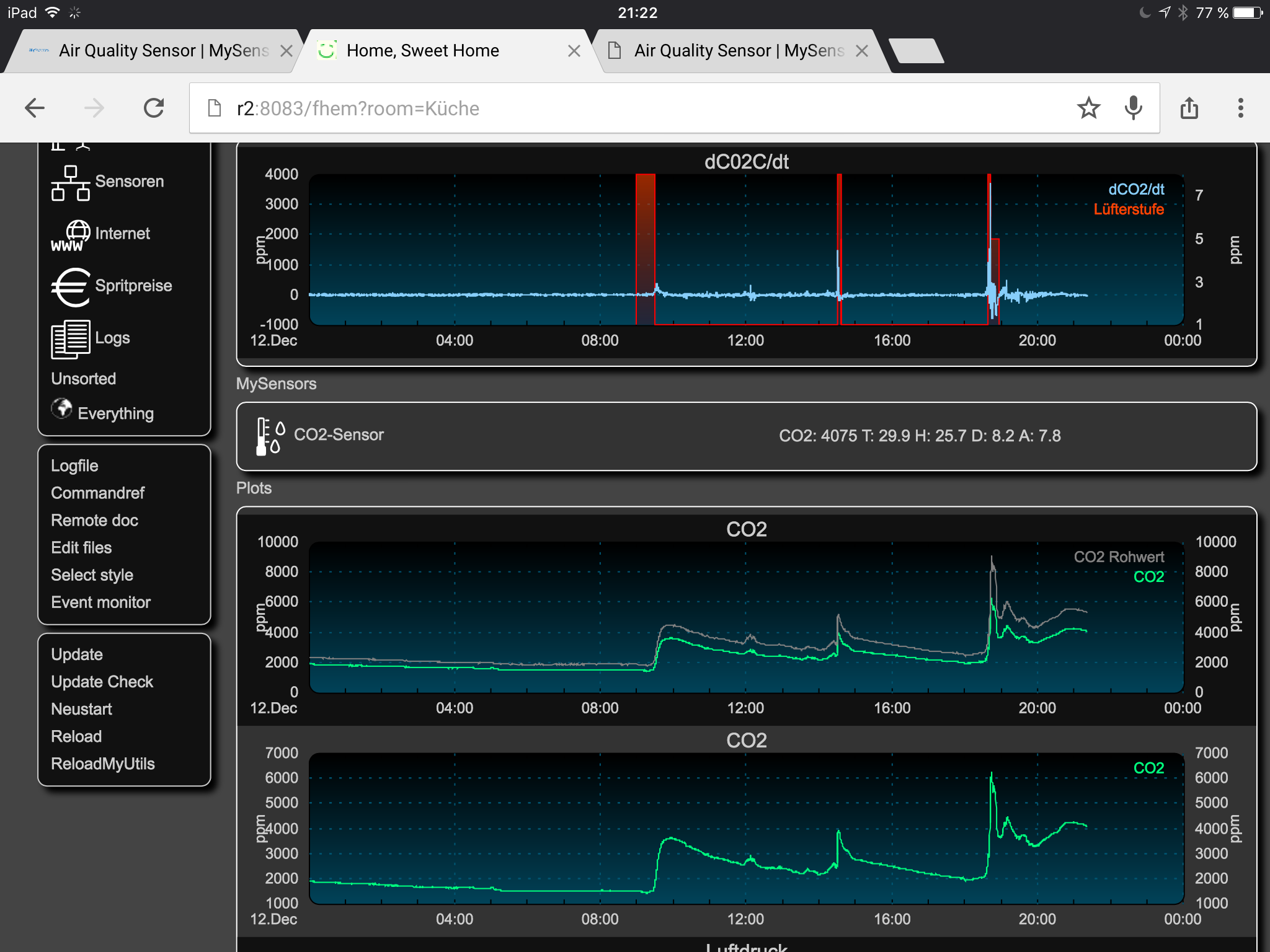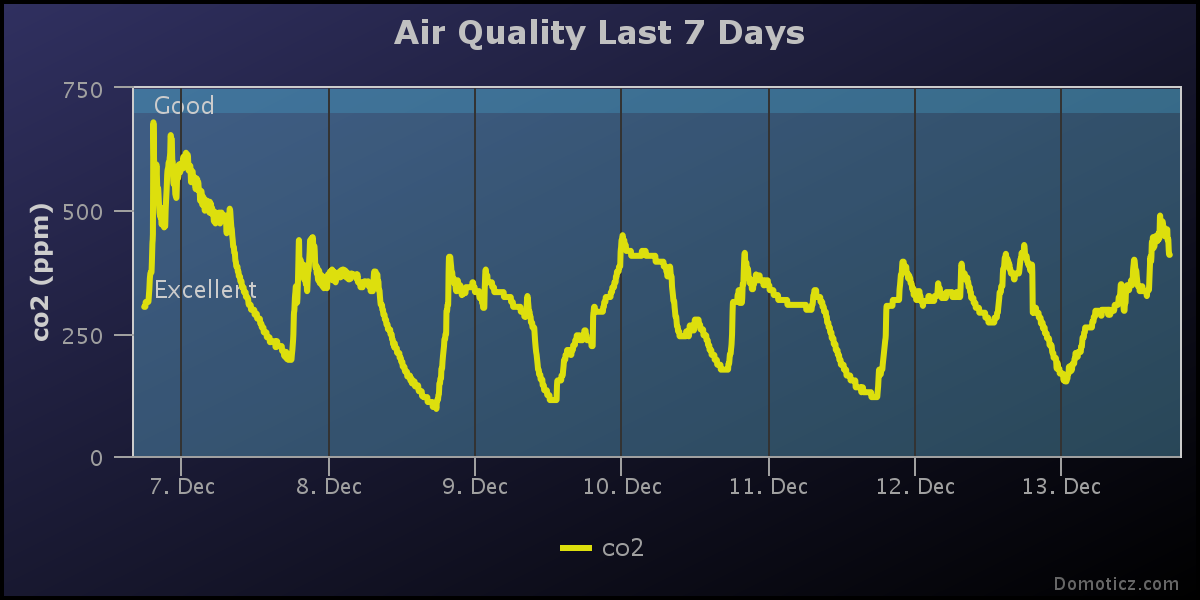Air Quality Sensor
-
@epierre Thanks for a rapid response!
Yes I've been trying to calibrate it assuming out door air is at 399ppm. I understand each one has variances but would like to know how you guys worked it out.
I'm using
ppm = 116.6020682 (Rs/Ro)^-2.769034857
from davide's blog http://davidegironi.blogspot.ch/2014/01/cheap-co2-meter-using-mq135-sensor-with.html#.VinvWX4rIuUSince the board show RL, I took that to calculate Rs. This lets me calculate Ro, thus calibrate it.
Not quite sure where I'm going wrong. I had it working 8 months ago, and came back to it and couldn't figure out how i had it working so well.. I was able to get pretty nice graphs and now its very unstable.
I'm having a play around with it, you can see my current points here https://thingspeak.com/channels/31162
@Yuki-M said:
@epierre Thanks for a rapid response!
Yes I've been trying to calibrate it assuming out door air is at 399ppm. I understand each one has variances but would like to know how you guys worked it out.
I'm using
ppm = 116.6020682 (Rs/Ro)^-2.769034857
from davide's blog http://davidegironi.blogspot.ch/2014/01/cheap-co2-meter-using-mq135-sensor-with.html#.VinvWX4rIuUSince the board show RL, I took that to calculate Rs. This lets me calculate Ro, thus calibrate it.
Not quite sure where I'm going wrong. I had it working 8 months ago, and came back to it and couldn't figure out how i had it working so well.. I was able to get pretty nice graphs and now its very unstable.
would say: let it burn for 24/48 hours to leave it clean itself ;-)
-
Adjusting my mq-135 sensor took several atempts as the CO2 value of the atmosphere is not a constant value of 399ppm.
This value is measured in Hawaii ( see http://co2now.org/ ) and is probably significantly lower than at your home. In germany for example you should calibrate your sensor when the wind comes from west over the atlantic which brings fresh air along. See http://www.donnerwetter.de/deutschland/co2.htmEverytime my sensor passed values below 400 I adjusted the R0 value. In the end I modified the sketch to be able to send this R0 value from FHEM to the sensor to avoid recompiling the sketch everytime.
See
https://github.com/windkh/mysensors/tree/master/CO2Sensor/CO2sensor.ino Line 440ff
-
The sensor is in my kitchen. The value in the screenshot is very high as I made some french fries 2 hours ago.

-
IN MiCS 2614 , sensitivity factor is defined by "Rs at 100 ppb of O3 divided by Rs at 50 ppb of O3". From where you measured Rs at 100 ppb or 50 ppb.???
@bhavika said:
IN MiCS 2614 , sensitivity factor is defined by "Rs at 100 ppb of O3 divided by Rs at 50 ppb of O3". From where you measured Rs at 100 ppb or 50 ppb.???
this is just to tell you how much a double concentration scales up, here they just say it is somehow linear at ratio 2
-
@Heinz very nice work :+1: (wie heisst du im FHEM Forum?)
Does someone have the values a MQ-07 needs to perform properly? I rally don't know how to gather the right values from the description.... :)
Thank you
-
@Rasenheizung if you base yourself on my template here https://github.com/empierre/arduino/blob/master/AirQuality-Multiple_Gas_Sensor1_4.ino
H2
1.3 50
0.8 100
0.28 400
0.16 1000
0.05 4000y = 73.59123879 x-1.355617483
Residual Sum of Squares: rss = 87393.44418
H2Curve[3] = {73.5912, -1.355617};CO
1.6 50
1 100
0.39 400
0.21 1000
0.09 4000y = 99.27731641 x-1.513643469
Residual Sum of Squares: rss = 43168.87424
COCurve[3] = {99.27731, -1.51364};CO is a dangerous gas, the MQ7 is very sensitive to many things and no calibration too... for a serious work please think about using the MICS-6814 that is calibrated, includes 3 gases out of the box, and is very low consumption (can run on battery !)
https://github.com/empierre/arduino/blob/master/AirQuality-CO-NO2-NH3.ino -
So what is the conditioning period for testing in it??? It is two days.. What does it mean??
@bhavika said:
So what is the conditioning period for testing in it??? It is two days.. What does it mean??
on this kind maybe to have it powered for a full two days to burn out the production "dusts" that may remain in.
those sensors are not good science, see the correlation of gases they are reported for in the datasheet
-
Hello,
a very sensitive HCHO module you can see a demo here: http://www.seeedstudio.com/recipe/379-a-handheld-hcho-detector.html?utm_source=EDM&utm_medium=EDM&utm_campaign=EDM20150930
https://github.com/empierre/arduino/blob/master/AirQuality-HCHO.ino
-
Looks strange, could you supply your code?
Btw the sensor draws a lot of current, the power supply should be able to deliver 1A. Did you burn in the sensor for 12-24 hours? -
I have used the code from epiere. Baking I have not done. I use different power supplies (USB, Samsung and a large controllable power supply). I sometimes feel that contacts do not function properly. But the sensor draws but only about 100 mA = 0.1 A? Then it seems to be on branding. I have three new sensors. Mostly we read that it is only an attempt here is to measure the CO2 content. When I check the values with a measuring instrument with which agree the details here https://olimex.wordpress.com/2015/05/26/experimenting-with-gas-sensors-and-arduino/ Branding should work outdoors? Can you show me a chart or values?
-
I used this library:
https://github.com/GeorgK/MQ135Together with this description:
https://hackaday.io/project/3475-sniffing-trinket/log/12363-mq135-arduino-librarySimple to use and very good explanations.


